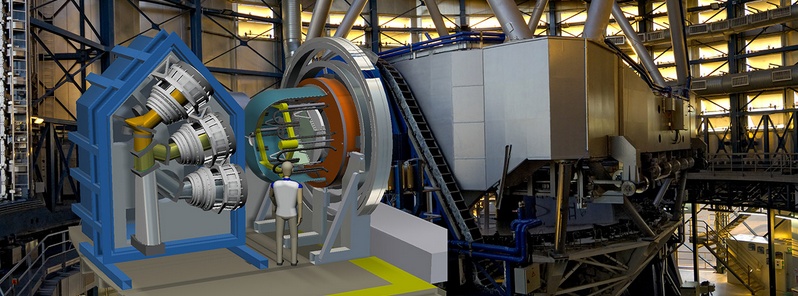MOONS to solve mysteries of how stars and galaxies evolve

A €9M contract was announced last week for UK-based engineers and designers to build MOONS (Multi-Object Optical and Near-infrared Spectrograph) that aims to tackle some of the most compelling astronomical puzzles – such as how stars and galaxies form and evolve, and probing the structure of our own Milky Way.
A project team from the UK Astronomy Technology Centre (UK ATC) in Edinburgh will lead this international project to develop and build MOONS for the European Southern Observatory’s (ESO) Very Large Telescope (VLT) in northern Chile.
As well as studies of the distant Universe, the infrared capabilities of MOONS will allow astronomers to study the highly obscured regions of the bulge of our galaxy. In combination with the power of the VLT, it will observe stars within the Milky Way up to a distance of about 40 000 light-years, looking through the Bulge and Disc to reveal their structure to create a three-dimensional map of our galaxy
“The team at UK ATC in Scotland have an opportunity with this project to enable all of us to understand why the Milky Way looks the way it does. This instrument will act as an intergalactic GPS to help us to navigate through the billions of stars in our galaxy and create a comprehensive map of its structure," says Director of the UK ATC, Professor Gillian Wright.
Building this ambitious device will take 200 staff-years of effort and UK ATC expects it to become operational by 2019. The hardware itself will cost €9M but the full project will be around €23M. The six countries involved in the MOONS project, alongside ESO are Chile, France, Italy, Portugal, Switzerland and the UK. In collaboration with the University of Cambridge and other UK universities, the UK ATC’s leading expertise in fields such as miniaturized mechanics and precision optics will be used on key aspects of the project.
The UK ATC will lead the Project Office managing the multinational consortium that will construct MOONS, playing a vital design role for key components needed to produce an instrument operating from 800 nm to 1.8 µm and featuring three individual spectrometers. The UK ATC will develop the most innovative component, the individual motorized systems allowing each fiber to move rapidly into position; it will also develop the cryostat system (used to cool MOONS down to -170°C) vital to enabling the infrared observations needed to penetrate galactic and intergalactic dust clouds.
Like any other spectrograph, MOONS will use the color of light emitted by objects to reveal their chemical composition, mass, speed and other properties. It will be observing 1000 objects using fibre-optic cables to feed their visible and infrared light into the instrument, it will survey large samples of objects far faster than any existing instrument and conduct surveys that are virtually impossible using today’s technologies. The design will pose extraordinary technical demands therefore. The international consortium will receive 300 nights of observations using the instrument once MOONS is operational.
Professor Roberto Maiolino from the University of Cambridge, Project Scientist for MOONS, says: “MOONS will vastly expand our knowledge of the mechanisms responsible for galaxy evolution across the life of the Universe. It will be possible to characterize the properties of millions of distant galaxies – for instance, by identifying the signatures of ongoing star formation and black hole accretion – and how galaxies’ evolution depends on their large-scale environment. Cambridge will play an essential role designing and assembling key optical subsystems, as well as in defining the science programme.”
Source: ESO
Featured image credit: STFC

Commenting rules and guidelines
We value the thoughts and opinions of our readers and welcome healthy discussions on our website. In order to maintain a respectful and positive community, we ask that all commenters follow these rules:
We reserve the right to remove any comments that violate these rules. By commenting on our website, you agree to abide by these guidelines. Thank you for helping to create a positive and welcoming environment for all.